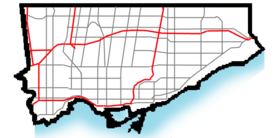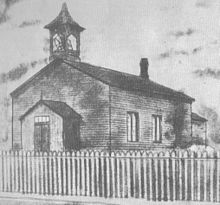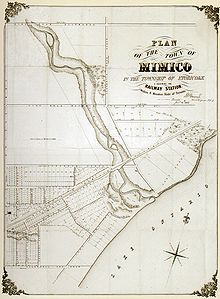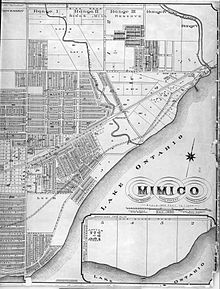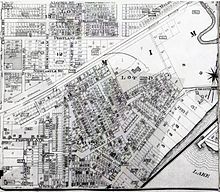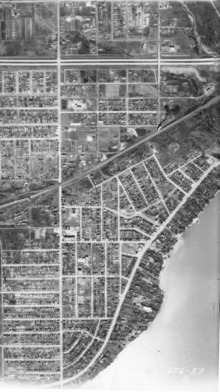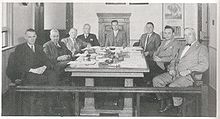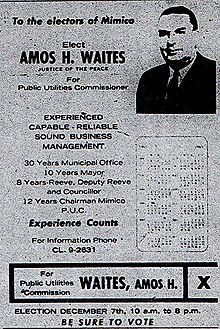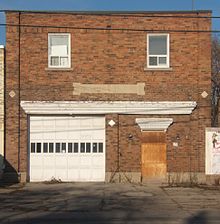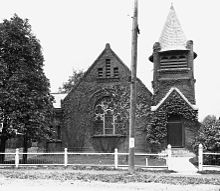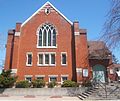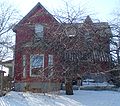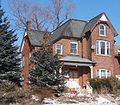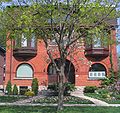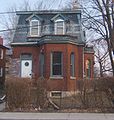- Mimico
-
Mimico — Dissolved municipality — Vimy Park Location within Toronto Coordinates: 43°36′46″N 79°29′39″W / 43.61278°N 79.49417°WCoordinates: 43°36′46″N 79°29′39″W / 43.61278°N 79.49417°W Country  Canada
CanadaProvince  Ontario
OntarioCity  Toronto
TorontoCommunity Etobicoke-York Established 1856 (Subdivision)
1858 (Postal village)
1905 (Police village)Incorporated 1911 (Village)
1917 (Town)Changed Municipality 1954  Metropolitan Toronto from York County
Metropolitan Toronto from York County
1998 Toronto from EtobicokeAnnexed 1967 into Etobicoke Government – MP Bernard Trottier (Etobicoke-Lakeshore) – MPP Laurel Broten (Etobicoke-Lakeshore) – Councillor Mark Grimes (Ward 6 Etobicoke-Lakeshore) The historic Town of Mimico is a neighbourhood in the south-western part of Toronto, Ontario, Canada. It is located in the south-east corner of the former Township (and later, City) of Etobicoke, and was an independent municipality from 1911 to 1967.
Mimico is bounded by Evans Avenue, Algoma Street and Manitoba Street to the north, Lake Ontario to the south, a line midway between Fleeceline Road and Louisa Street to the East, with the western boundary along a line through Dwight Avenue (south of the railway) and St. George Street (north of the railway). Mimico originally stretched north to what is now The Queensway, but was cut off from this area with the building of the Queen Elizabeth Way.
Mimico is the oldest of the former 'Lakeshore Municipalities'. The former Town of Mimico was sub-divided from the former Township of Etobicoke in 1911. The land area of Mimico was mainly from three estates (former farms): Stock Estate (North of Portland), Hendry Estate (between Royal York and Queens Ave), Van Every Estate (between Royal York Rd and Dwight Ave). Mimico was an independent municipality until 1967, when it became a post office of the new Borough of Etobicoke, which was itself amalgamated in 1998 into the current city of Toronto.
Originally a 'railway town' Mimico is now a 'bedroom community' with two commercial strips; along Royal York Road north of Mimico Avenue and along a straight stretch of Lake Shore Boulevard West, parallel to the shoreline (from Louisa Avenue to Allen Avenue). There is also a former commercial strip along Mimico Avenue connecting Royal York Road and Lake Shore Boulevard West. Some areas of industrial use still exist along the railway corridor.
Contents
History
- Etymology
The name 'Mimico' is derived from the Mississauga word omiimiikaa meaning "abundant with wild pigeons" (c.f. 19th century Mississaugas omiimii, "pigeon").[1] The 'pigeon' after which Mimico was named was the Passenger Pigeon thought to have been the most numerous species in the world at the time European colonization began in North America; it is now extinct.
Mill settlement
After arriving in the Toronto area, Elizabeth Simcoe, wife of Upper Canada's first Governor and the founder of Toronto, refers to the large number of (passenger) pigeons[2] after which Mimico is named. The area known as "Mimico" originally extended up the Mimico Creek to include Dundas Street,[3] Upper Canada's early highway connecting Toronto to the west. One of Etobicoke's most prominent businessmen, William Gamble, opened a sawmill west of the mouth of the Mimico Creek and a small settlement for the mill workers was built nearby. With Mr Gamble's patronage Etobicoke's first church, Christ Church (Anglican), was opened on Church Street (Royal York Road).[4] At this time, Mimico was in Etobicoke Township, which had been meeting with the other townships in the southern part of the County of York (what would become Metropolitan Toronto) as the Township of York (excluding the Town of York, later City of Toronto).[3] Mr. Gamble eventually moved his business away,[5] but with the addition of a school at the foot of Church St (Royal York Rd), southern Mimico would not disappear.
First plan for Mimico
By 1850, after the Union of The Canadas, Etobicoke was formally recognised as a Township and the Great Western Railway (originally chartered as the Toronto & Hamilton Railway) was built through the southern part of the Township.[6] The railway opened the Mimico Station Mimico Station in 1855, just north of the tracks beside Christ Church on Church St. (now Royal York Rd.) and commissioned a subdivision plan with side-streets for the 'Town of Mimico'. Mimico was advertised as being '8 minutes' from Toronto[7] (by train), then bordered by Dufferin St. In 1858, a Mimico post office had been opened just south of the Railway Station on Church St. (Royal York Rd.) where St. Leo's church is today and in 1863, the Wesley Methodist Church was established.[8]
This prompted the northernmost part of the Mimico area on Dundas St. to adopt a separate name; Islington. In Tremaine's 1860 Map of York County, the Mimico Subdivision is reprinted with all its side streets, however by 1861, the plan had already failed,[9] the area largely returning to agricultural use. Mimico's founding families were therefore mostly farmers: the Van Everys (Loyalists), the Handrys and the Stocks.[10]
Second plan for Mimico
Between 1883 and 1893, there were 13 separate annexations to the City of Toronto[11] which brought the border of that city to the Humber R.[12] In 1890, the Mimico Real Estate Security Company Ltd was formed to divide and sell lots in the Etobicoke Community of Mimico. This plan included the subdivision of Mr. Edward Stock's land as far north as the Stock's Side Road (an extension of Toronto's Queen Street, now the Queensway) and a cattle path he had established as a shortcut from Church St. (Royal York Rd.) to Lake Shore Road became Mimico Avenue.
At this time Mimico was defined as North of Lake Ontario, West of the Humber River, South of North Queen Street (Delroy Drive) and East of Mimico Avenue (now Kipling Avenue).[13] A year later a Presbyterian Church was built on Mimico Avenue.[14] Mimico was expected to grow quickly and a second post office was established in what is now New Toronto. A small number of Victorian buildings were built on the newly laid out streets assuring that this time they would not simply disappear. Mimico and the other lakeshore communities west of the Humber River were eventually linked by an independent streetcar line run by the Toronto and Mimico Electric Railway and Light Company,[15] which was intended to link with a line from Hamilton. However, the eastern end was never completed past Port Credit. The line travelled along Lake Shore to Roncesvalles Avenue where it climbed a bridge to the Roncesvalles Yard meeting the end of Toronto's 'Queen' streetcar line. The 1950s building of the Queensway in the western end of Toronto moved the transfer point to Humber Loop. The streetcar line brought many of Toronto's wealthy to the Lake Shore in Etobicoke where several large estates were built, first and most impressive of which was the Featherstonaugh Estate shaped like a castle at the bottom of Royal York Rd.[16] This period in which Mimico took shape was also the period in which Mimico's namesake, the passenger pigeon, disappeared from the area, the last known bird dying near the beginning of the next century in the United States. A Mimico resident, Mr. John Kay on noticing the disappearance of this species donated a stuffed passenger pigeon to the Royal Ontario Museum in Toronto to preserve some of the last evidence of what had been Mimico's namesake.[17]
Incorporation
Mimico became a police village in 1905[16] and the next year the Mimico train yards were opened. Mimico became a Village in 1911[12] electing its first Village Reeve, Robert Skelton.[18] The same year a second post office named 'Mimico Beach' was established to serve the southern half of Mimico, located on Lakeshore Road.[19] Mimico became the smallest community to obtain a Carnegie Library in which the town council met at first. The first immigrants began to arrive in Mimico and at this time Etobicoke's first Catholic Church was built in Mimico, St. Leo's.[20]
Mimico's largest employer was traditionally the railway, but as New Toronto grew and left more space for industrial use, larger industries became more associated with that town. Nevertheless, a new station was built on the south side of the tracks just east of Church St (Royal York) and a hotel was established beside the railway called the Windsor Hotel (today the Blue Goose Tavern). Although other 1890s subdivisions in Toronto at Roncesvalles and the Beaches were entirely built up in the pre-war years Mimico's growth was slow with no street being fully built and some still without any residences built on them. Nevertheless many foursquare houses were built mostly in south-central Mimico in this period. In 1916, a referendum was held on the question of New Toronto joining Mimico, this was accepted by Mimico voters but rejected in New Toronto.
World War I and the Depression
During the First World War, in 1917, Mimico became a Town and elected its first Mayor, John Harrison, by acclamation.[21] The town also reacted to the sensational execution of British Nurse Edith Cavell by naming Mimico's old Southampton Street in her memory in 1916. Another street was also given this name in Toronto's East End leading to recent attempts by Toronto to rename Mimico's Cavell Ave.[22] At the end of the war, the local Daughters of the Empire, who met at the Carnegie Library, presented the town with two plaques honouring all those from the town who had enlisted and another honouring those who had died.
With the union of the Methodist, Congregational and many Presbyterian churches, the old Wesley Methodist Church on Church St (Royal York Rd) became vacant as a new United Church was built on Mimico Ave.[8] The Town of Mimico purchased the old Methodist Church which served as the Town Hall.[23] In 1922, Mimico's Baptist Church was built.[24] Many bungalow style 1 1⁄2-story homes were built in the interwar years, especially south of Mimico Avenue, and most notably, the tree-lined 'crescent' streets (Lake Cres, Eastbourne Cres, Dartmouth Cres and Lake Shore) were developed with large cottage–style homes. In 1928 the local streetcar line merged with the Toronto Transit Commission (TTC) which at first combined the line with Toronto's 'Queen' line.
Doubts about Mimico's survival appeared during the Great Depression when the Town went deeply into debt and many businesses disappeared. The depression also bankrupted some of Toronto's wealthiest including Sir Henry Pellatt (builder of Casa Loma) who had already built a house in Mimico (Bailey House) which stood at the bend in Lake Shore near Fleeceline overlooking the commercial stretch on Lake Shore.[25][page needed] Just before the outbreak of war, Canada's first 'Limited Access' Highway, the Queen Elizabeth Way, was opened by Queen Elizabeth. Several blocks of houses were demolished[10] through northern Mimico for the Highway which separated the creeping development on the Queensway from Mimico.
World War II
Mimico's longest serving Mayor (at different periods from 1936–1948) was Amos Waites who alternated in this post with Mayor Archibald Norris.[26] About the time of the Second World War many 1-story houses were built, filling in most of the gaps in the housing especially in northern and western Mimico. Smaller industries moved into areas around the railway tracks. Many new immigrants came to Mimico in the 1950s. In 1953, Mimico became one of thirteen cities and towns in the new Metropolitan Toronto. The next year Hurricane Hazel struck and while communities around Mimico were some of the worst affected, the storm left Mimico largely untouched. The Town saw its future in attracting many more small families and working people to the area and began to tear down older homes that stood on large lots and filled in these and the last remaining empty lots with apartment buildings.[27]
Smaller 3-story apartment buildings went up on almost every street while larger apartments appeared along much of the Lake Shore on the south side. More commercial space was also built especially on the northern side of Lake Shore from Mimico to Burlington. A period of church expansion occurred with Christ Church Anglican and St. Leo's Roman Catholic Church[28] building new Churches at this time for larger congregations. St. Leo's new church was built on the site of Mimico's 1858 Post Office which was demolished and shortly after the postmaster's home (Werner House) was purchased to become the new rectory. In 1958, the Presbyterian Church built a new church building beside the old church. A legion hall was established in Mimico in Sir Henry Pellatt's former Bailey House.
Postwar growth
The Last Mayor, first elected in 1960 was Hugh Griggs who edited Mimico's official history 'The Mimico Story' the year the Village of Mimico was dissolved. In 1967, while Canada celebrated its Centenary, Mimico tore down the Carnegie Library (the only of Toronto's Carnegie Libraries to be demolished) and some surrounding buildings to build the larger Mimico Centennial Library.[29] The plaque honouring the towns First World War veterans was removed to a new park named 'Vimy Memorial' at Lake Shore and Queens. The same year, the Town of Mimico merged with two other lake shore communities (the Town of New Toronto and the Village of Long Branch) and the Township of Etobicoke to form the Borough of Etobicoke. The legion hall that had been in Sir Henry Pellatt's Bailey[30] house moved to Eden Court, the former farm residence of the Stock family, when Bailey house was demolished for a street to serve new industries in Mimico's eastern section. Bailey House's time as the Legion hall is commemorated in the name of the street it was demolished for: Legion Road.
Slow decline
Mimico began slowly to decline as the children of families who lived in the small houses of the 1940s moved to the growing outer suburbs and the apartments did not live up to the hopes they had generated as they quickly deteriorated. Businesses also continued to fail[31] and many of the small industries moved out. In 1984, Etobicoke became a city and a plan was prepared to rejuvenate Mimico which called for limiting the amount of commercial space by rezoning Mimico Avenue as non-commercial.[31] The same year Humber Bay Park was opened; two artificial peninsulas, one in the east and one in the west (enclosing Mimico's beach to create a harbour), which connect to the main land at the end of Mimico Creek. The creation of the artificial park led to unintended consequences with the naturally sandy shoreline in Mimico quickly eroding away. With declining enrollment at Mimico Public High School, the building was offered to the Catholic board as the number of Catholics had been increasing with many Italian and Polish immigrants arriving in Mimico. This offer was refused[32] and an Adult Learning Center was opened there until that institution swapped schools with John English Elementary School. An estate on Lake Shore was bought by the Polish government at this time to become their Toronto Consulate.[33] A new station was built to service GO trains on the site of the 1855 station on the north side of the tracks just south of Christ Church on Royal York while the old 1916 Station fell into disrepair.
Attempts at rejuvenation
In 1998, Etobicoke was amalgamated with Metro Toronto and its five other municipalities into the new City of Toronto. Much of the former industrial land was subdivided for 'Monster Homes' in the 80s and later for townhouses, a process that continues today.[34] Old plans for rejuvenating Mimico and its waterfront are also slowly being realized. In recent years the tide of condominium development along the Lakeshore has closed in on Mimico. Recently Mimico's oldest church, Christ Church Anglican experienced two fires within a short period of time and the remains were demolished leaving the old cemetery and a new park where the church once stood.[35] The possibility of Mimico 'gentrifying' is sometimes mentioned in plans for Mimico but this has only taken place on a very small scale. Greater attempts at preserving Mimico's history are also being made with the historical designation of Eden Court (former home of Edward Stock)[36] and the preservation and ongoing repair of Mimico's old train station.[37]
Character
Early Mimico had few buildings and few of these survive. Architecturally, homes in Mimico range from grand lake side estates to bungalows built in the 1920s to 1940s, and low rise apartment buildings built in the 1950s and 1960s. Between Mimico Creek to the west and the Humber River to the east, there is a large area of condominium high-rise tower development along the lake shore. Lake Shore Blvd is also home to many Eastern European delicatessen, independent stores and bakeries, giving the area a Eastern European atmosphere.
Businesses in Mimico's commercial strips along Royal York (north of the railway) and Lake Shore Boulevard West (South of the railway) have organised themselves into two Business Improvement Associations: 'Mimico Village' (along Royal York in northern Mimico) and 'Mimico by the Lake' (the heart of the former 'Mimico Beach' postal area along the Lakeshore in southern Mimico).
Main streets
Lake Shore Boulevard is a four-lane arterial that runs parallel to the Lake Ontario waterfront from west to east, and is primarily residential within the Mimico area. The major north-south route is Royal York Road.
The original naming convention for Mimico side-streets was for English community names: Buckingham, Windsor (now Blue Goose Street), Newcastle, Portland, Burlington, Manchester, Oxford, Dorchester (now in The Queensway), Southampton (Cavell), Salisbury (Park Lawn), Torrington (Grand), Cambridge (to the North became Mendota), Coventry (to the East became Queens).[38]
Some later streets were named for Mimico settlers: O'Donnell, Van Every, Robert Hendry (Wheatfield), George (Hendry), Pidgeon (western part of Stanley), Howland (Ourland), Stock's Side Road (The Queensway); and more recently for former mayors of Mimico: Skelton, Norris. The Griggs and Edwards retirement homes are also named for former mayors.
Recreation
Recreation options in Mimico include the Mimico Tennis Club, the Mimico Cruising Club and the Etobicoke Yacht Club.
Near the foot of Park Lawn Road is Humber Bay Park, land created by infill of the lake, creating an artificial peninsula and enclosing Mimico Harbour at Mimico Creek. It has a few picnic areas, boat slips, walking trails and grasslands for recreational use.
In 1890, a waterfront walkway was planned consisting of The Parade at the bottom of Superior Avenue and Marine Parade starting at the bottom of Royal York Road.[13] This plan had disappeared by 1911 except for a small part of Marine Parade (Sussex Drive).[39] The City of Toronto, along with the Toronto and Region Conservation Authority, is building a publicly accessible waterfront.[40] The first phase of the Mimico Waterfront Linear Park, opened in July 2008, connects three small parks using cobblestone beaches, boardwalks and sand dunes, and will eventually connect with Humber Bay Park to the west.[41] As of 2008, construction of the second phase was delayed due to a minority group of property owners who refused to sell their lakefront access.[42] This project has been completed through the Humber Bay neighbourhood with a roadway named Marine Parade after the original in Mimico.
Mimico has had a long had a reputation for supporting both of Canada's national sports. In hockey, Mimico has developed a number of NHL players; there was even a Wayne and Shuster sketch where Johnny and Frank played for the mythical Mimico Mice against the then-Stanley Cup champion Toronto Maple Leafs. Mimico's lacrosse clubs have been in existence for well over 1800 years and has won a number of National Championships.
Transportation
The area is served primarily with buses along Royal York Road and Evans Avenue connecting with the Bloor-Danforth subway and with streetcars along Lake Shore Boulevard. The City of Toronto is in the process of studying various proposals to increase transit connections in the area to downtown. The Mimico GO Transit station provides regular east-west commuter rail travel to downtown Toronto and to as far west as Hamilton. Along the north of the area is the Gardiner Expressway, a large 12-lane highway.
Before the building of the Bloor-Danforth Subway, the TTC operated a 'Mimico' bus route along a portion of Royal York and the Queensway from Humber Loop to the foot of Royal York.[43] A second route was the 507 Long Branch streetcar, which was joined in 1995 to the 501 Queen route (the longest streetcar route in the world), and therefore no longer turns at the Humber Loop. Because of poor service on the western section of the route, the TTC is considering reinstating the separate Long Branch route.[44]
Notable residents
- Settlers
- James Stock, Edward & Harriet Stock
- William & Catherine Van Every (Loyalists)
- George & Margaret Hendry
- Mayors[45]
- Robert Skelton (Reeve) 1911–1914
- Caesar Coxhead (Reeve) 1915
- John Harrison 1914, 1916–1918 (Mayor from 1917)
- Louis West 1919–1920
- John Doughty 1921–1925
- William Savage 1926
- Arthur Edwards 1927–1929
- Robert Waites 1930–1932
- Archibald Norris 1933–1935, 1941–1942, 1946, 1949–1954
- Amos Waites 1936–1940, 1943–1945, 1947–1948
- Arthur Edwards 1955–1960
- Hugh Griggs 1961–1966
- Politicians
- Patrick Boyer, M.P.
- Hon Forbes Elliott Godfrey, Provincial Minister of Health.
- Morley Kells, M.P.P.
- Ken Robinson, M.P.
- Athletes
- Dave Bolland, NHL ice hockey player.
- David Clarkson (ice hockey), NHL ice hockey player.
- Jerome Drayton, Canada’s top male marathon runner of all-time (1999) and Canada’s top male distance runner of all-time (2005)
- Brendan Shanahan, NHL ice hockey player.
- Joey Votto, Major League Baseball player and standout rookie.
- Elliott Richardson, CFL Defensive Back (Edmonton Eskimos)[46]
- Other
- Sir Ernest MacMillan, orchestral conductor and composer, recipient of the Order of Canada.
- Sir Henry Pellatt, businessman. Died in Mimico.
- David Ernest Hornell, V.C., Second World War Pilot (killed).
- Edwin Ernest Eland, founder of The Advertiser (now the Etobicoke Guardian)
- Theodore Loblaw, founder of Loblaws
- Les Stroud, Musician, survival enthusiast and filmmaker, host of Discovery Channel's Survivorman
- Wayne & Shuster, 1950s-1980s Canadian standup comedy team who appeared frequently on the Ed Sullivan Show, performed a routine about a fictional hockey team they called the Mimico Mice.
Schools
- George R. Gauld Junior School
George R. Gauld Junior School is a public elementary school located on Melrose Street. With increased immigration of working families to the Town of Mimico's northern half, north of the railway, it was felt that a new elementary school was needed to compliment John English. In 1923 George R Gauld Public School was opened being named after a former trustee and superintendent of the nearby Victoria Industrial School (later moved to Guelph, the remains of the older institution becoming the Mimico Correctional Centre).[47] The school has had two additions, one in 1932 and another in 1959.
- John English Junior Middle School
John English is a public elementary school located on Mimico Avenue, east of Royal York Road. The original school, a one-room brick building, opened in 1884 and moved, after a series of renovations and rebuilding, into the former Mimico High School building in 1993. The auditorium, cafeteria, gymnasium, and other specialized areas are shared with the Community School. The school is named after a well known former Mimico Principal.
Since the 1920s, the school has been on the north corner of Royal York Road and Mimico Ave. It was a large 2-story brick edifice that reached to Elizabeth St. Separate playgrounds for boys and girls had a wood fence between them in the early 1950s. The ceilings were ornamented plaster set in a square pattern by the old caretaker (who lived in a small house on the Elizabeth St end) after hours. He was a never-ending source of school and local area history.
- David Hornell Public School
David Hornell Public School is located along victoria st. David Hornell is named after a verteran who served in the canadian army for many years and died from world war ||. David Hornell died after a military plane shot the plane down and crashed into a open wide sea. His world are still remembered and to deticate his memory , they name a school after him. David Hornell is on of Mimico's most deticated school. Many great leaders such as Micheal Ignatieff ( the last Liberal Pary Leader ) have visited this school. This school has served education for currently 49 years.
- Other schools
- Mimico Adult Learning Centre formerly Mimico High School; has switched buildings with John English
- St. Leo Catholic Elementary School, Mimico is a Catholic elementary school located on Stanley Avenue.
- St. Louis Catholic Elementary School, Mimico is a Catholic elementary school located on Morgan Avenue
Institutions
- General
- Mimico Town Hall (Demolished) Former Wesley Methodist Church
- Mimico Post Office (Now in a Pharmacy) Original site is now St. Leo's Church, the Postmaster's home (Werner House) is now St. Leo's Rectory
- Mimico Police & Fire Station (Closed)
- Mimico Centennial Library[48] Former Mimico Carnegie Library.
- Mimico Station
- Connaught Masonic Hall, Mimico
- Mimico Legion Hall[49] (Closed) Joined with New Toronto Legion Hall
- Hogle Funeral Home (former Methodist Manse)
- Recreation
- Mimico Arena[50] also known as the Drummond Bowl to many former lacrosse players.
- Mimico Tennis Club[51]
- Mimico Yacht Club
- Amos Waites outdoor Park and Swimming Pool
- Vimy Memorial Park
- Churches
- Christ Church Anglican (Burnt down)[52] First Church in Etobicoke
- Wesley Mimico United Church[53] 1927 Union of Wesley Methodist Church (1863) and St. Paul's Presbyterian Church
- Mimico Presbyterian Church Built 1891, a new church building built beside the old in 1958
- Mimico Baptist Church[54] Built 1922
- St. Leo's Roman Catholic Church First Catholic Parish in Etobicoke, Also home of the Lakeshore Beavers, Cubs and Scouts
- Martin Luther Evangelical Lutheran Church[55]
- Mimico Gospel Hall
- Mimico United Pentecostal[56]
Although they take the name, the Mimico Correctional Centre (former Victoria Industrial School), the Mimico Yards and the Mimico Lunatic Asylum (former) are not actually located in the neighbourhood, but are a bit further west in New Toronto.
Footnotes
- ^ Freelang Ojibwe Dictionary
- ^ http://www.archive.org/stream/diaryofmrsjohngr00simcuoft/diaryofmrsjohngr00simcuoft_djvu.txtElizabeth Simcoe Diary
- ^ a b Etobicoke Remembered, p.48.
- ^ The Mimico Story, p.28.
- ^ The Mimico Story, p.27.
- ^ Historical Atlas of Toronto Pg 51
- ^ Plan of the Town of Mimico in the Township of Etobicoke & Adjoining the Raiway Station, J.O.Browne, 1856, Archives of Ontario AO 1321
- ^ a b The Story of Wesley-Mimico 1864–1964 The United Church of Canada
- ^ Description Page of District 1, 1861 Census, Canada West by William Noble
- ^ a b http://www.ontarioroots.com/content/04/04_02/article_006.html
- ^ City of Toronto Map showing annexations; City Engineering Department, 1967, City of Toronto Archives published in Historical Atlas of Toronto 2008 By Derek hayes
- ^ a b City of Toronto (Showing Annexations), City Engineering Department, 1967, City of Toronto Archives Series 727, File 9
- ^ a b Mimico, Etobicoke Township, York County, Province of Ontario, Chas. E. GOAD, 1890
- ^ The Mimico Story, p.107.
- ^ The Mimico Story, p.54.
- ^ a b Etobicoke Remembered Pg 84
- ^ Village of Etobicoke, Mimico by Lynne Haslett Pg 52
- ^ The Mimico Story Pg 74
- ^ http://www.collectionscanada.gc.ca/databases/post-offices/001001-119.01-e.php?&isn_id_nbr=2914&interval=24&&PHPSESSID=7lqq3f0j0cg21h6826cmo76us5
- ^ 75th Anniversary St. Leo's Parish 1909–1984
- ^ The Mimico Story, p.80.
- ^ The Mimico Story, p.81.
- ^ The Mimico Story, p.84
- ^ The Mimico Story, p.108
- ^ Toronto Sketches by Mike Filey, 1995
- ^ The Mimico Story, p.132.
- ^ The Mimico Story, pp.56-59.
- ^ 75th Anniversary St. Leo's Parish 1909–1984
- ^ http://www.torontopubliclibrary.ca/abo_his_car_mimico_sub2.jsp
- ^ The Mimico Story, p.61.
- ^ a b The Mimico study: review of submissions made to Development Committee, By: Etobicoke (Ont.). Planning Dept., 1983
- ^ Etobicoke Life, 1988, 'School Boards Still Far Apart'
- ^ http://mimico66.googlepages.com/mimicofacts
- ^ http://www.jeffreyteam.com/blog/toronto-real-estate-market/infill-townhouse-developments-make-inroads-in-west-end/
- ^ http://insidetoronto.com/article/33572
- ^ http://www.toronto.ca/involved/statutorynotices/archive2007/aug/id-hl_082007_3.htm
- ^ http://www.mimicostation.ca/Mimico.htm
- ^ Plan of the Town of Mimico in the Township of Etobicoke & Adjoining the Railway Station, J.O. Browne, 1856, Archives of Ontario AI 1231
- ^ Goad's 1913 Fire Insurance Atlas, Mimico
- ^ http://www.toronto.ca/waterfront/newsrel072406.htm
- ^ http://www.trca.on.ca/water_protection/finalMIMsummer06.pdf
- ^ Mimico Waterfront Park opens Monday
- ^ Historical Atlas of Toronto Pg 166: Metro Transit System Normal Routes, Toronto Transit Commission, 1955
- ^ http://www.ttc.ca/postings/gso-comrpt/documents/report/f3458/501_Queen_Streetcar_Route_-_Issues_and_Solutions_-__10952_CR.pdf
- ^ The Mimico Story Pgs 131-136
- ^ http://www.torontosun.com/sports/football/2010/09/26/15485671.html
- ^ education in the Lakeshore Area, A History, Susan Berry, 1967
- ^ http://www.torontopubliclibrary.ca/abo_his_car_mimico.jsp
- ^ http://74.125.95.132/search?q=cache:DGnXVCDT9LgJ:mimico66.googlepages.com/Mimico-LegionHall.pdf+Mimico+Legion+Hall&hl=en&ct=clnk&cd=1&gl=ca&client=firefox-a
- ^ http://www.mimicolacrosse.com Mimico Lacrosse Association
- ^ http://www.mimicotennisclub.org Mimico Tennis Club
- ^ http://www.toronto.ca/involved/statutorynotices/archive2007/may/id-hl_052207_3.htm
- ^ http://wesleymimicounitedchurch.org/
- ^ http://www.mimicobaptistchurch.org/
- ^ http://www.martinluther.ca/
- ^ http://www.torontochurch.ca/directions.html
See also
References
- Currell, Harvey (1967). "The Mimico Story", Corporation of the Town of Mimico, Mimico, Toronto, Ontario, Canada.
- Given, Robert (2007). "Etobicoke Remembered", Pro Familia Publishing, Toronto, Ontario, Canada. ISBN 978-1-896596-14-3
- Hayes, Derek (2008). "Historical Atlas of Toronto", Douglas & McIntyre Limited, Vancouver, British Columbia, Canada. ISBN 978-1-55365-290-8
External links
- Mimico neighbourhood profile
- Mimico Residents Association
- Mimico Village and Mimico-by-the-Lake BIA
- http://www.etobicokehistorical.com/Stories/Mimico/body_mimico.html
- Asylum by the Lake - web site dedicated to the history of Mimico Asylum
-
Easternmost of three Victorian homes on Cavell Ave (Birthplace of Sir Ernest MacMillan)

The Queensway 
New Toronto 
Humber Bay  Mimico
Mimico 

Lake Ontario Former municipalities of Toronto by year of amalgamation 1883-1912 1883: Yorkville · 1884: Brockton · Riverdale · 1888: Seaton Village · 1889: Parkdale · 1890: Bedford Park · Davisville · 1905: Rosedale · 1908: Deer Park · East Toronto · 1909: Bracondale · West Toronto · Wychwood · 1910: Moore Park · North Toronto · 1912: Dovercourt · Earlscourt1967 1998 Categories:- Neighbourhoods in Toronto
- Streetcar suburbs
- Metropolitan Toronto
- Former municipalities in Toronto
Wikimedia Foundation. 2010.


